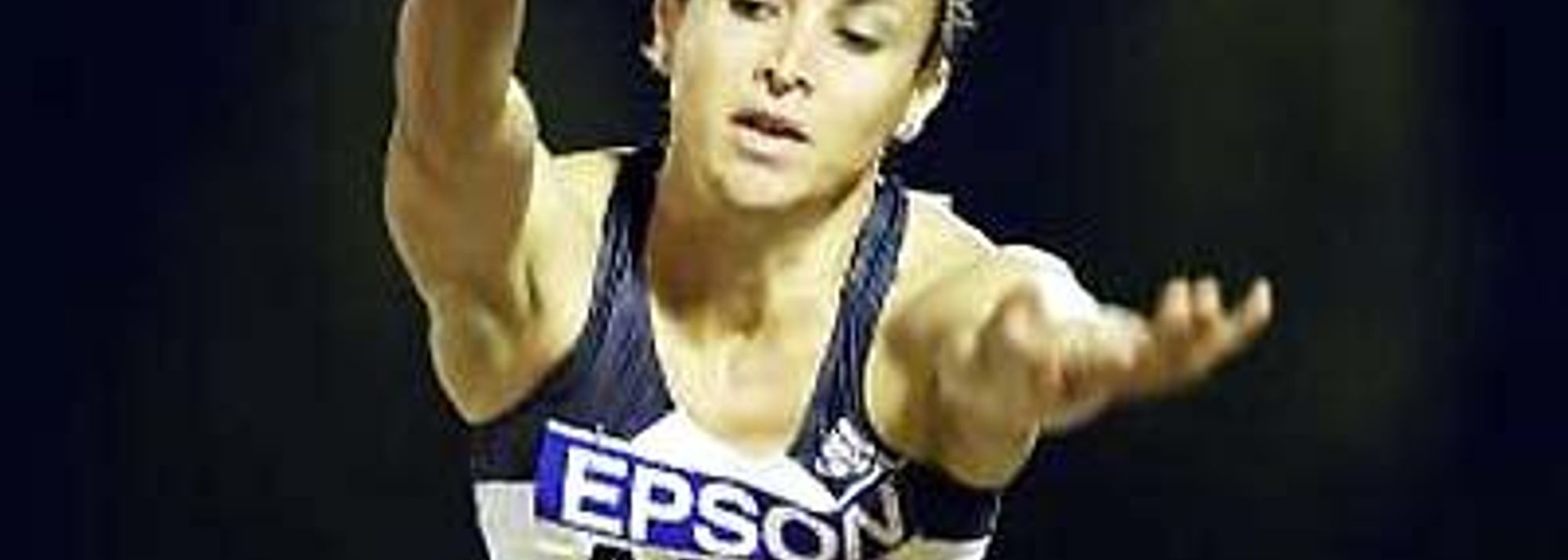Maurren Maggi (BRA) (© Getty Images)
Maurren Higa Maggi of Brazil well and truly established herself in the ranks of the world’s best long jumpers in 2002. One of only four women to surpass 7 metres in competition with out undue wind assistance, she spent the season chasing the heals of world leader Tatyana Kotova of Russia, and in one memorable competition in Paris on 14 September jumped 7.02m (her legal season’s best) to beat her Russian adversary to win the IAAF Grand Prix Final.
After finishing the season in 31st overall place in the IAAF World Rankings, and 2nd in her event, the Long Jump, Maggi the 2001 Goodwill Games winner had one of the best years of her career in 2002. In 15 competitions at the Long Jump she only lost three times, on all occasions - Stockholm, Thessaloniki, Madrid - to Kotova. The latter of these loses, her second place in Madrid with a leap of 6.81m, came in what was a generally lack lustre competition but it was enough to gain her second place on the world stage at the IAAF World Cup.
Maggi is a multi-talented athlete with a 13.23 100m Hurdles win and two 14 metre plus Triple Jump competitions also to her credit this year. So how does Maggi describe such a successful season?
“At the beginning of the season, we had a goal with Nelio and Tânia (her coaches, Nelio and Tânia Moura). That goal was to have as many competitions as possible between 6.80 and 6.90m; to jump over 7 metres again, and to be at the podium of the main events of the year.”
“In March I competed 2 times in the Triple Jump, basically because we do some exercises in training that involve the mechanics of the Triple, so we decided to try it seriously in a few events. It was successful, (she broke the South American record twice, to leave it at 14.32), but my main event is still the Long Jump.”
“This has been a very special season for me. Since 1999, and at the end of each competitive year, my coaches and me sit down to analyze everything, and every time, I have the feeling that I have had the best year of my career.”
In 2001, I had several good victories in Europe, won the gold medal at the World University Games and the Goodwill Games; it was almost a perfect year. But after 2002, I have no doubts that it was the best so far, and believe I still have lots of room for improvement.”
“Everything was going well up until May. Then, warming up for the Triple Jump competition at the Ibero-American Championships in Guatemala, I suffered a muscular injury, and for a moment I thought I had lost the whole season. Happily, the rehab went very well, and I could go back to the Grand Prix circuit without any problems. That was the toughest moment of the year.”
“The happiest? The victory at the Grand Prix Final in Paris with my legal best of the year, 7.02m.”
“Many people in the world still don’t know me, and I would describe myself as a very determined and persevering person. As an athlete, my coaches say that I have the perfect technical and mechanical conditions to be a good jumper. I also think that to compete and succeed at the highest levels, you have to be a happy person, and I am one. I have great relationships with my family, my friends, my coaches, and besides that, I have the much needed support of my club since 1996 (BM&F), and my sponsors. I also have the support of the Brazilian Confederation and of one of the National Team sponsors, the state bank “Caixa”.”
“My goals for 2003 are high, but simple. I want to defend my Pan-American title, aim at a medal at both World Championships (Indoor and Outdoor), and be more consistent over 7 meters.”
“To win a medal at a World Championships is one of the goals of my career. The other one is to be on an Olympic podium as well. After this season, I think I have pretty good chances in the Long Jump. But if in the future, in a main competition, the Triple is scheduled after the Long, I would definitely try it on that event. That would be pretty amazing!”
“My country, Brazil has produced lots of sports idols, such as Ronaldo, Ayrton Sena, Gustavo Kuerten or Gustavo Borges. They have been a great inspiration for me.”
“Some people think that there’s no talent for Athletics in South America. That’s a big mistake. I personally think that the area is having a great evolution, and will just be a matter of time until we reach the level of the most developed areas of the world. We still lack organized initiatives to detect and develop talents, and there are also very few places that have supporting programmes for athletes of higher levels. That’s all we need.”
Eduardo Biscayart for the IAAF
Maurren Maggi’s season
At 100mh (SB)
13.23/0.2 1 São Caetano do Sul 23.03
At LJ (all competitions)
7.01/1.3 1 São Caetano do Sul 09.03
6.95/2.9 1 São Caetano do Sul 23.03
(6.62/1.1)
7.17/2.6 1 São Paulo 13.04
(6.92/1.6)
6.89/-1.0 1 Guaita Santiago de Chile 28.04
6.90/0.0 1 GP Belém 05.05
6.97/1.0 1 IbAm C. de Guatemala 11.05
6.571.3 1 Cork 06.07
6.83/1.2 2 DNG Stockholm 16.07
6.82/0.8 2 Thessaloníki 24.07
6.84/0.3 1 WK Zürich 16.08
6.78/0.7 1 Norw London 23.08
7.02/2.0 1 GPF Paris 14.09
6.81/1.9 2 WCp Madrid 21.09
6.86/0.9 1 TB Rio de Janeiro 29.09
6.20/0.0 1 Manaus 09.11
At TJ (all competitions)
14.21/-0.9 1 São Caetano do Sul 09.03
14.32/1.0 1 São José do Rio Preto 16.03
13.42/0.2 11 GGala Roma 12.07
13.80/0.6 1 TB Rio de Janeiro 27.09



